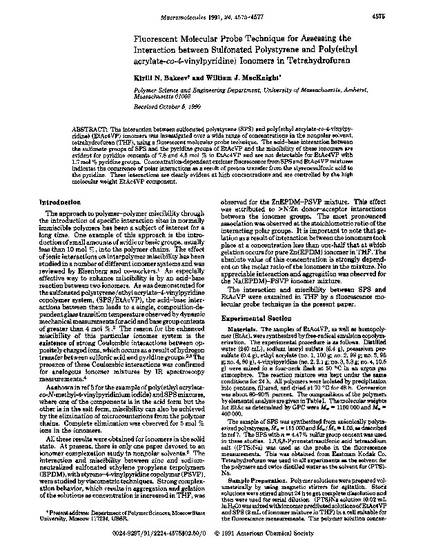
Article
Fluorescent Molecular Probe Technique for Assessing the Interaction between Sulfonated Polystyrene and Poly(ethyl acrylate-co-4-vinylpyridine) Ionomers in Tetrahydrofuran
Macromolecules
(1991)
Abstract
The interaction between sulfonated polystyrene (SPS) and poly(ethy1 acrylate-eo-4-vinylpyridine)
(EtAc4VP) ionomers was investigated over a wide range of concentrations in the nonpolar solvent,
tetrahydrofuran (THF), using a fluorescent molecular probe technique. The acid-base interaction between
the sulfonate groups of SPS and the pyridine groups of EtAcVP and the miscibility of these ionomers are
evident for pyridine contents of 7.8 and 4.5 mol 5% in EtAc4VP and are not detectable for EtAc4VP with
1.7 mol % pyridine groups. Concentration-dependent excimer fluorescence from SPS and EtAc4VP mixtures
indicates the occurrence of polar interactions as a result of proton transfer from the styrenesulfonic acid to
the pyridine. These interactions are clearly evident at high concentrations and are controlled by the high
molecular weight EtAc4VP component.
Keywords
- Fluorescent Molecular Probe,
- Interaction,
- Sulfonated Polystyrene,
- Poly(ethyl acrylate-co-4-vinylpyridine),
- Ionomers,
- Tetrahydrofuran
Disciplines
Publication Date
1991
Citation Information
William MacKnight and Kirill N. Bakeev. "Fluorescent Molecular Probe Technique for Assessing the Interaction between Sulfonated Polystyrene and Poly(ethyl acrylate-co-4-vinylpyridine) Ionomers in Tetrahydrofuran" Macromolecules Vol. 24 (1991) p. 4575 - 4577 Available at: http://works.bepress.com/william_macknight/278/
